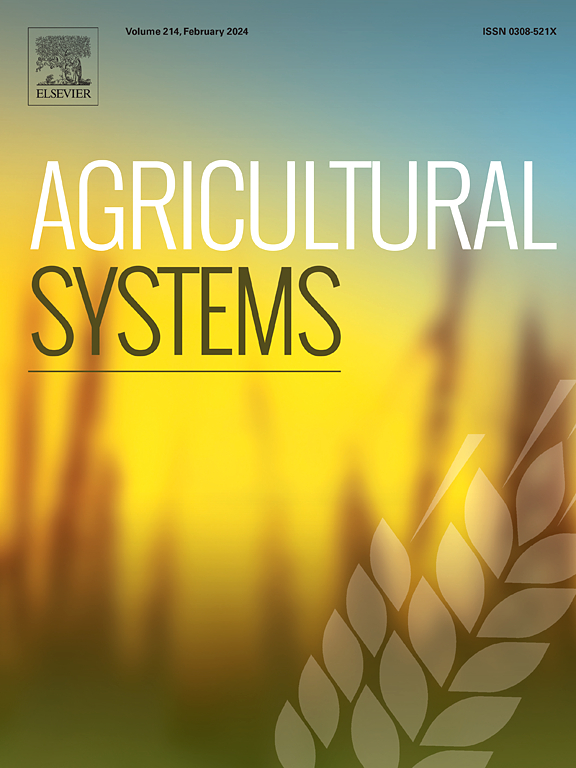林场、围场树木和线性农林复合系统对农业生产力的影响:全球定量分析
IF 6.1
1区 农林科学
Q1 AGRICULTURE, MULTIDISCIPLINARY
引用次数: 0
摘要
农林业为农业景观带来了许多好处,包括木材生产、碳封存和增强生物多样性。至关重要的是,农林业还影响牧场、作物和牲畜的生产力。然而,由于农林业类型(例如,防风林、小巷、森林牧场)、树木状况(例如,高度、年龄、物种)、种植地点和气候条件等因素,影响的大小和方向变化很大。然而,目前关于量化这些驱动因素的变化如何影响农林业对农业产量的影响的信息有限。目的:在这篇定量综述中,我们旨在确定相对于无树比较,森林、围场树木和线性农林复合系统对农业生产力的影响程度。此外,我们试图了解农林业的影响如何随树木状况、气候和天气等因素而变化。方法对两种关键的农林业类型(非间作线性系统,如防风林和树篱,以及分散的牧场系统,如围场树木和森林牧场)进行了全球文献综述。提取了这些系统与无树对照相比的农业生产力响应,并将效果的大小与农林复合系统的一系列条件进行了比较,例如树木密度、树龄、与树的距离以及一系列气候和天气条件。结果和结论对于所研究的农林业类型,我们发现了强有力的证据基础,即线性农林业类型(防风林、林道)对作物/牧草生长的影响,以及围场树木/森林放牧系统对牧草生长的影响(在这些系统中未检测作物生长)。关于线性农林复合系统对畜牧业生产的影响的资料有限。线性农林复合特征总体上有利于作物和牧草的生长。相比之下,森林放牧系统导致了牧场和牲畜生产力的降低,尽管这种系统可能为减轻风险提供其他好处。树木条件是影响效应大小的主要因素,线性配置下的围场大小和林荫系统下的树木密度是影响效应大小的主要因素。气候变量也影响农林业对生产力的影响,这表明在预测影响大小时需要考虑当地和季节气候变化。该研究为评估线性和分散农林业类型对农业生产力的影响以及预测在何种条件下这些影响将得到优化提供了重要的基线信息。这些资料将有助于设计和执行有效的农林业系统。本文章由计算机程序翻译,如有差异,请以英文原文为准。

Effect of silvopasture, paddock trees and linear agroforestry systems on agricultural productivity: A global quantitative analysis
CONTEXT
Agroforestry provides numerous benefits to agricultural landscapes, including timber production, carbon sequestration and enhanced biodiversity. Critically, agroforestry also influences the productivity of pasture, crops, and livestock. The magnitude and direction of the effect, however, is highly variable due to factors including the type of agroforestry (e.g., windbreak, alley, silvopasture), the condition of the trees (e.g., height, age, species), planting location and climatic conditions. However, currently there is limited information that quantifies how variation in these drivers affects the influence of agroforestry on agricultural yields.
OBJECTIVES
In this quantitative review we aimed to determine the magnitude of the effect that silvopasture, paddock trees and linear agroforestry systems have on agricultural productivity relative to a treeless comparison. In addition, we attempted to understand how the effect of agroforestry varied with factors such as tree condition, climate, and weather.
METHODS
A global literature review was conducted examining two key agroforestry types (non-intercropped linear systems such as windbreaks and hedges, and dispersed pasture systems such as paddock trees and silvopasture). Agricultural productivity responses of these systems compared to a treeless control were extracted and the size of the effect was compared to a range of conditions of the agroforestry systems e.g. tree density, age, distance to tree, as well as a range of climate and weather conditions.
RESULTS AND CONCLUSIONS
For the agroforestry types examined we found a strong evidence base for the effects on crop/pasture growth for linear agroforestry types (windbreaks, alleys) and on pasture growth in paddock tree/silvopasture systems (crop growth was not examined in these systems). There was limited information on the effects of linear agroforestry systems on livestock production. Linear agroforestry features were generally beneficial for crop and pasture growth. By comparison, silvopasture systems resulted in a reduction in both pasture and livestock productivity, although such systems are likely to provide other benefits for mitigating risk. Tree condition was a major factor driving effect size, the most prominent drivers being paddock size in linear configurations, and tree density in silvopasture systems. Climate variables also influenced the effect of agroforestry on productivity, indicating that both local and seasonal climate variation needs be considered when predicting effect sizes.
SIGNIFICANCE
This study provides important baseline information for valuing the effects linear and dispersed agroforestry types have on farm productivity and predicting under what conditions these effects will be optimised. Such information will aid in designing and implementing effective agroforestry systems.
求助全文
通过发布文献求助,成功后即可免费获取论文全文。
去求助
来源期刊

Agricultural Systems
农林科学-农业综合
CiteScore
13.30
自引率
7.60%
发文量
174
审稿时长
30 days
期刊介绍:
Agricultural Systems is an international journal that deals with interactions - among the components of agricultural systems, among hierarchical levels of agricultural systems, between agricultural and other land use systems, and between agricultural systems and their natural, social and economic environments.
The scope includes the development and application of systems analysis methodologies in the following areas:
Systems approaches in the sustainable intensification of agriculture; pathways for sustainable intensification; crop-livestock integration; farm-level resource allocation; quantification of benefits and trade-offs at farm to landscape levels; integrative, participatory and dynamic modelling approaches for qualitative and quantitative assessments of agricultural systems and decision making;
The interactions between agricultural and non-agricultural landscapes; the multiple services of agricultural systems; food security and the environment;
Global change and adaptation science; transformational adaptations as driven by changes in climate, policy, values and attitudes influencing the design of farming systems;
Development and application of farming systems design tools and methods for impact, scenario and case study analysis; managing the complexities of dynamic agricultural systems; innovation systems and multi stakeholder arrangements that support or promote change and (or) inform policy decisions.
 求助内容:
求助内容: 应助结果提醒方式:
应助结果提醒方式:


